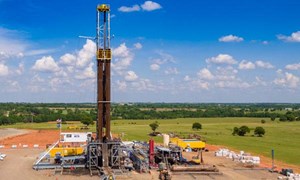Shale’s fiscal discipline means missing out on rising oil prices
(Bloomberg) --Shale’s newfound prudence after last year’s crash is putting producers in the unusual situation of reducing oil output just as prices surge.
More focused than ever on keeping spending in check, shale drillers haven’t been boring new wells fast enough to keep up with output declines in older ones. So, next month, their combined production will edge lower by 47,000 barrels a day to about 7.46 million, according to the U.S. Energy Information Administration. That’s despite an oil price jump of more than 30% this year.
The impact of the coronavirus on energy consumption was so bad last year that several heavily indebted shale producers went under after years of being bankrolled by Wall Street. Now, producers don’t seem to be in a rush to start another boom, and their backers aren’t either. That’s good news for Saudi Arabia, which has sought to bring prices up without unleashing a new supply glut.
“We are still observing only about 50% of last year’s rig count activity,” EIA analyst Jozef Lieskovsky said by email. “With such a low rig count, even with the increased productivity, production declines in all regions are possible.”
The number of rigs drilling for oil in the U.S. started plunging when the pandemic hit, reaching just 172 in August, down from 683 late in March 2020, according to Baker Hughes data. They are now at little more than 300.
In theory, producers also have the option of fracking wells that have been drilled but left uncompleted, known as DUCs. But that wouldn’t help them conserve much capital because the process of blasting a mixture of water, chemicals and sand into the ground to unleash oil and gas from shale rock is the most expensive part of a well’s development. DUCs also require some work before they can be fracked if they’ve been lying idle for too long.
Output will be slightly lower in nearly all key shale regions except for the Permian Basin of West Texas and New Mexico, which is estimated to produce a meager 11,000 barrels a day more, the EIA said in its Drilling Productivity Report.
Click here to subscribe to the World Oil energy newsletter, and receive exclusive industry news and analysis in your inbox each weekday.



